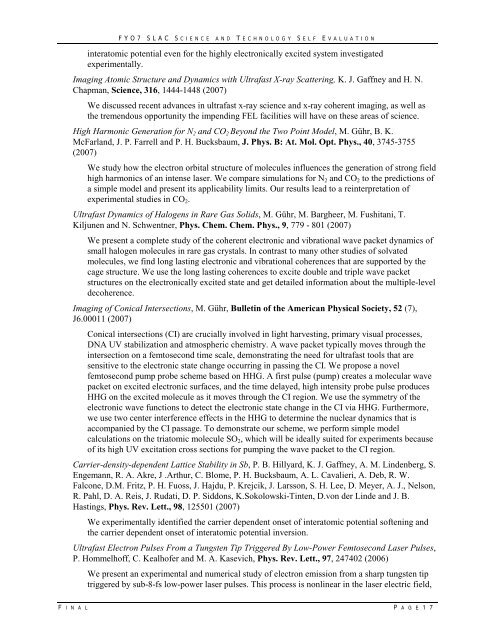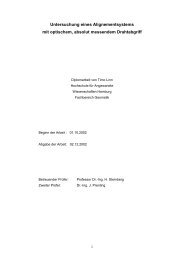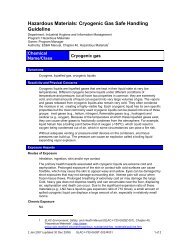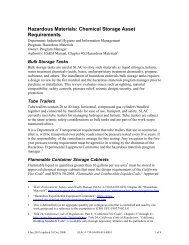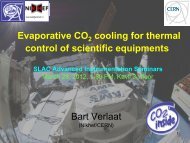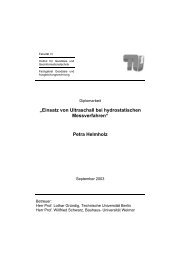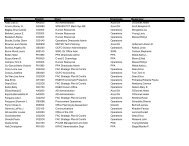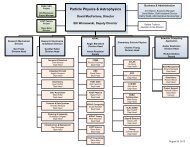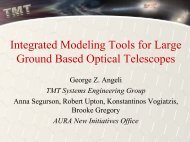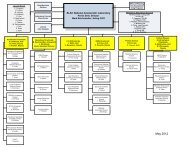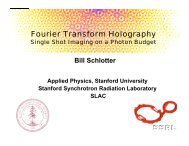BES - SLAC Group/Department Public Websites - Stanford University
BES - SLAC Group/Department Public Websites - Stanford University
BES - SLAC Group/Department Public Websites - Stanford University
You also want an ePaper? Increase the reach of your titles
YUMPU automatically turns print PDFs into web optimized ePapers that Google loves.
FYO7 <strong>SLAC</strong> S CIENCE AND T ECHNOLOGY S ELF E VALUATION<br />
interatomic potential even for the highly electronically excited system investigated<br />
experimentally.<br />
Imaging Atomic Structure and Dynamics with Ultrafast X-ray Scattering, K. J. Gaffney and H. N.<br />
Chapman, Science, 316, 1444-1448 (2007)<br />
We discussed recent advances in ultrafast x-ray science and x-ray coherent imaging, as well as<br />
the tremendous opportunity the impending FEL facilities will have on these areas of science.<br />
High Harmonic Generation for N2 and CO2 Beyond the Two Point Model, M. Gühr, B. K.<br />
McFarland, J. P. Farrell and P. H. Bucksbaum, J. Phys. B: At. Mol. Opt. Phys., 40, 3745-3755<br />
(2007)<br />
We study how the electron orbital structure of molecules influences the generation of strong field<br />
high harmonics of an intense laser. We compare simulations for N2 and CO2 to the predictions of<br />
a simple model and present its applicability limits. Our results lead to a reinterpretation of<br />
experimental studies in CO2.<br />
Ultrafast Dynamics of Halogens in Rare Gas Solids, M. Gühr, M. Bargheer, M. Fushitani, T.<br />
Kiljunen and N. Schwentner, Phys. Chem. Chem. Phys., 9, 779 - 801 (2007)<br />
We present a complete study of the coherent electronic and vibrational wave packet dynamics of<br />
small halogen molecules in rare gas crystals. In contrast to many other studies of solvated<br />
molecules, we find long lasting electronic and vibrational coherences that are supported by the<br />
cage structure. We use the long lasting coherences to excite double and triple wave packet<br />
structures on the electronically excited state and get detailed information about the multiple-level<br />
decoherence.<br />
Imaging of Conical Intersections, M. Gühr, Bulletin of the American Physical Society, 52 (7),<br />
J6.00011 (2007)<br />
Conical intersections (CI) are crucially involved in light harvesting, primary visual processes,<br />
DNA UV stabilization and atmospheric chemistry. A wave packet typically moves through the<br />
intersection on a femtosecond time scale, demonstrating the need for ultrafast tools that are<br />
sensitive to the electronic state change occurring in passing the CI. We propose a novel<br />
femtosecond pump probe scheme based on HHG. A first pulse (pump) creates a molecular wave<br />
packet on excited electronic surfaces, and the time delayed, high intensity probe pulse produces<br />
HHG on the excited molecule as it moves through the CI region. We use the symmetry of the<br />
electronic wave functions to detect the electronic state change in the CI via HHG. Furthermore,<br />
we use two center interference effects in the HHG to determine the nuclear dynamics that is<br />
accompanied by the CI passage. To demonstrate our scheme, we perform simple model<br />
calculations on the triatomic molecule SO2, which will be ideally suited for experiments because<br />
of its high UV excitation cross sections for pumping the wave packet to the CI region.<br />
Carrier-density-dependent Lattice Stability in Sb, P. B. Hillyard, K. J. Gaffney, A. M. Lindenberg, S.<br />
Engemann, R. A. Akre, J .Arthur, C. Blome, P. H. Bucksbaum, A. L. Cavalieri, A. Deb, R. W.<br />
Falcone, D.M. Fritz, P. H. Fuoss, J. Hajdu, P. Krejcik, J. Larsson, S. H. Lee, D. Meyer, A. J., Nelson,<br />
R. Pahl, D. A. Reis, J. Rudati, D. P. Siddons, K.Sokolowski-Tinten, D.von der Linde and J. B.<br />
Hastings, Phys. Rev. Lett., 98, 125501 (2007)<br />
We experimentally identified the carrier dependent onset of interatomic potential softening and<br />
the carrier dependent onset of interatomic potential inversion.<br />
Ultrafast Electron Pulses From a Tungsten Tip Triggered By Low-Power Femtosecond Laser Pulses,<br />
P. Hommelhoff, C. Kealhofer and M. A. Kasevich, Phys. Rev. Lett., 97, 247402 (2006)<br />
We present an experimental and numerical study of electron emission from a sharp tungsten tip<br />
triggered by sub-8-fs low-power laser pulses. This process is nonlinear in the laser electric field,<br />
F I N A L P A G E 1 7


